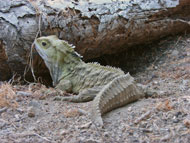A zoo’s reptile house holds many wonders.
 I almost got to hold a tuatara. |
While a pet store is most likely the first place many children will see their first living-and-breathing reptiles, let’s not forget the delights that can often be found at the reptile house in a zoo. The naturalistic vivariums they typically have on display are great enough, but zoos are often the only place the general public can see certain animals. I’m talking the rare ones, sometimes endangered species, and new animals that have not yet entered the reptile hobby.
Years ago I was at the San Diego Zoo and, of course, the reptile house is my first stop when I go there (of course they make it easy, as it’s right near the entrance). There I was, making my way around the vivariums on display, when I came upon one of the large snake enclosures. Inside one of them was the first albino Burmese python I had ever seen. My eyes just about popped out of my head when they fell upon that beautiful snake.
A similar experience awaited me on a subsequent visit, when I saw my first in-the-flesh Fiji banded iguana.
Zoos can provide reptile fans with a peek at animals they will see nowhere else. Another San Diego Zoo resident is the tuatara. I first saw their tuataras when I was there on a tour, as part of the 2005 TSA (Turtle Survival Alliance) conference that was held in San Diego that year. The TSA attendees were given a behind-the-scenes tour of the zoo’s reptile area prior to a barbecue on the grounds one evening. During the tour we were shown the tuatara breeding habitat. Sandy Quinn, my sales manager on REPTILES magazine, was in a different group than me, and people in hers were offered a chance to hold a tuatara. Nobody in my group was given that opportunity and I think Sandy still secretly delights in having been able to do so while I was not.
Now that I think of it, the San Diego Zoo – or maybe it was the Los Angeles Zoo – may have been the first place I saw my first green iguana. This would have been back around 1970, when I first came to California when I was 9 years old. I still have a photo of the green iguanas I saw, whichever zoo it was (they’re sitting on a grass lawn, with no tell-tale signs of which zoo they may be at). Prior to my family’s move to California we were living in a small New Jersey town. I don’t even remember a pet store in town, and I definitely don’t remember ever seeing a green iguana before the ones we photographed in California.
Of course, Komodo monitors are a prime attraction at many zoos. Who doesn’t love to see one stalking around, with that large tongue flitting in and out? And it was a zoo – the National Zoological Park in Washington, DC – that played a huge role in the captive breeding of Komodo monitors. If it weren’t for Trooper Walsh and his associates at the National Zoo, we likely wouldn’t see as many Komodos in zoos today as we do. Thanks, Trooper! (You can thank him personally if you like, at any of the reptile expos he attends these days as part of the Chondro Coalition.)
I especially enjoy a good swamp exhibit, and one of the best I ever saw was at the Tennessee Aquarium (ok, ok, maybe it’s not technically a zoo, but I’m still counting it as one for the purposes of this here blog). They had the hugest alligator snapping turtle I’ve ever seen. That guy’s head was the size of a ghetto blaster.
Speaking of the South, another one of my for-the-first-time reptile viewings was back in 1994. I’ve mentioned this in a past blog, but that was the leucistic alligators at the Audubon Aquarium of the Americas. (I guess since this is the second official public aquarium I’ve mentioned, consider this blog to be touting the virtues of aquariums as well as zoos – the ones that have reptile displays, anyway.) Those alligators were definitely unique (and still are) and eye-catching, all white and with blue eyes. For years I had a rubber leucistic alligator thumbtacked to my office wall to commemorate that visit.
Zoo turtle exhibits always make me envious. Alas, I do not have the space at home to install anything near as impressive as the turtle enclosures at many zoos. To see how big and healthy turtles can get when kept in the proper enclosures is always a thrill. The last time I was at the San Diego Zoo (what can I say? I go there more than any other zoo) I loved observing the outdoor enclosure that was housing gharials – and where else but at a zoo will the average reptile hobbyist see those? – and huge specimens of various Asian turtle species. It’s still there, for anyone who wants to check it out.
Of course, it’s always fun to people watch at the reptile house, too, especially the wide-eyed kids pulling their parents from display to display. The reptiles aren’t the only things on display, plenty of visitor’s enthusiasm is, too. It does a herp lover’s heart good to see that.
If you haven’t been to your local zoo for too long, get yourself to it. Remember, too, some great zoos are in other cities. Think about including them in future vacation plans. If you want to create a major reptile-oriented trip, consider attending either a Turtle Survival Alliance conference or a future International Herpetological Symposium. Both are typically hosted by a zoo, and trips to that zoo, with behind-the-scenes tours are often included on their itineraries.



